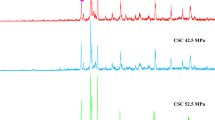Abstract
The evolution in time of the strength and porosity of mortars made with the same type of high-alumina cement and two different types of aggregate, calcareous and siliceous, is studied, and the effects of aggregate composition on both parameters are analysed. It is found that between strength and porosity a linear correlation exists. The effects of pore diameter on such correlation is investigated and it is ascertained that the best correlation can be obtained for total cumulative porosity. The results show that this correlation can be useful for the determination of compressive strengthin situ.
Résumé
On étudie l’évolution dans le temps de la résistance et de la porosité de mortiers confectionnés avec le même type de ciment alumineux et deux types différents de granulats, calcaire et siliceux, et on analyse les effets de la composition du granulat sur les deux paramètres.
On constate qu’il existe une corrélation linéaire entre la résistance et la porosité. On examine les effets du diamètre des pores sur une telle corrélation et on établit qu’on peut obtenir la meilleure corrélation pour la porosité totale. Les résultats montrent que cette corrélation peut servir pour déterminer la résistance à la compressionin situ.
Similar content being viewed by others
References
Hakim, M. F., “Étude de l’hydratation du ciment alumineux associé à des granulats calcaires, conséquences sur les propriétés mécaniques’, Thèse de Docteur Ingénieur, INSA, Toulouse (1984).
Bachiorrini, A., ‘Interaction physico-chimique entre l’aluminate monocalcique et différents carbonates au cours de la réaction d’hydratation’, Thèse de Doctorat, Université Claude Bernard, Loyon I (1985).
Indelicato, F. and Cussino, L., ‘Comportement viscoélas-tique à long terme des bétons de ciment alumineux’, in Proceedings of 8th International Congress on the Chemistry of Cement, Rio de Janeiro, 1986, Vol. VI, pp. 556–561.
Cussino, L. and Negro, A., ‘Hydratation du ciment alumineux en présence d’agrégat siliceux et calcaire’, in Proceedings of 7th International Congress on the Chemistry of Cement, Paris, 1980, Vol. III, pp. V-62-V-67.
Negro, A., Cussino, L. and Bachiorrini, A., ‘Sull’idratazione dell’alluminato monocalcico in presenza di quarzo e di carbonato di calcio’,Il Cemento 75 (3) (1978) 285–290.
Bachiorrini, A. and Guilhot, B., ‘Premières échéances de l’hydratation de l’aluminate monocalcique: influence du protocole de stoppage’,Cem. Concr. Res. 12 (5) (1982) 559–567.
Collepardi, M., ‘Scienza e Tecnologia del Calcestruzzo’, (Hoepli, Milano, 1980).
Neville, A., ‘High-alumina cement-A current review’,Il Cemento 75 (3) (1978) 291–302.
Ryshkewitch, E., ‘Compression strength of porous sintered alumina and zirconia’,J. Amer. Ceram. Soc. 36 (2) (1953) 65–68.
Bal’shin, M. Y., ‘Relation of mechanical properties of powder metals and their porosity and the ultimate properties of porous metal-ceramic materials’,Dokl. Akad. Nauk SSSR 67 (1949) 831–834.
Shiller, K. K., ‘Skeleton strength and critical porosity in set sulphate plasters’,Br. J. Appl. Phys. 11 (1960) 338–342.
Watson, K. L., ‘A simple relationship between the compressive strength and porosity of hydrated Portland cement’,Cem. Concr. Res. 11 (3) (1981) 473–476.
Moriconi, G., ‘Alcune considerazioni sulla microstruttura delle paste di cemento con particolare riferimento alla porosità’, in Proceedings of Giornate di Studio sulla Caratterizzazione delle Superfici, Granulometrie e Porosità dei Materiali e dei Prodotti Industriali, Torino, June 1986, pp. 85–90.
Massidda, L. and Sanna, U., ‘Relazioni porosità-resistenza in manufatti cementizi’, in Proceedings of Giornate di Studio sulla Caratterizzazione delle Superfici, Granulometrie e Porosità dei Materiali e dei Prodotti Industriali, Torino, June 1986, pp. 91–96.
Odler, I. and Rössler, M., ‘Investigations on the relationship between porosity, structure and strength of hydrated Portland cement pastes. II Effect of pore structure and of degree of hydration’,Cem. Concr. Res. 15 (3) (1985) 401–410.
Smolczyk, H. G. and Romberg, H., ‘Der Einfluss der Nachbehandlung und der Lagerung auf die Nacherhärtung und Porenverteilung von Beton (Teil I)’,Tonind.-Ztg. 100 (10) (1976) 346–357.
Idem,, ‘Der Einfluss der Nachbehandlung und der Lagerung auf die Nacherhärtung und Porenverteilung von Beton (Teil II),ibid. 100 (11) (1976) 381–390.
Bachiorrini, A., ‘Porosità e resistenza meccanica dei compositi a base di cemento alluminoso: la porosità critica’, in Proceedings of Giornate di Studio sulla Caratterizzazione delle Superfici, Granulometrie e Porosità dei Materiali e dei Prodotti Industriali, Torino, June 1986, pp. 97–99.
Washburn, E. W.,Proc. Natl. Acad. Sci. 7 (1921) 115.
Author information
Authors and Affiliations
Rights and permissions
About this article
Cite this article
Indelicato, F. On the correlation between porosity and strength in high-alumina cement mortars. Materials and Structures 23, 289–295 (1990). https://doi.org/10.1007/BF02472202
Issue Date:
DOI: https://doi.org/10.1007/BF02472202




